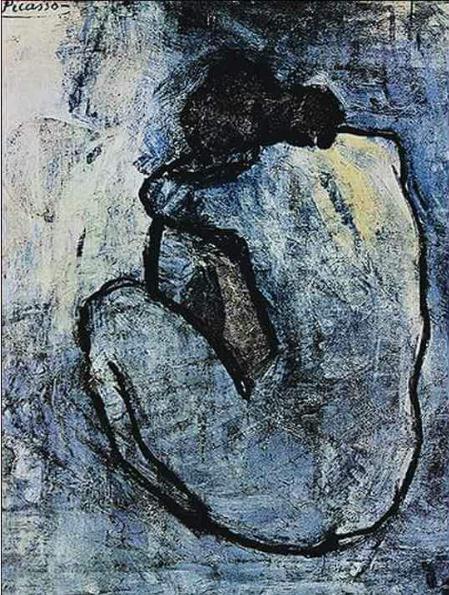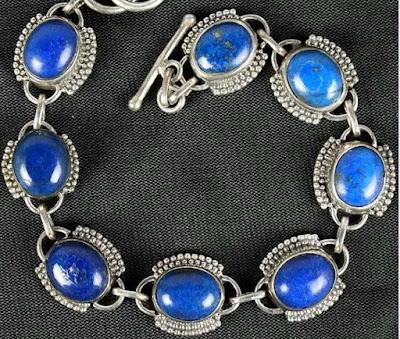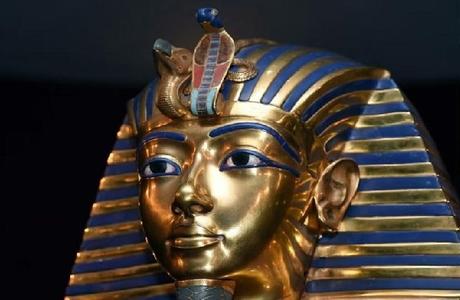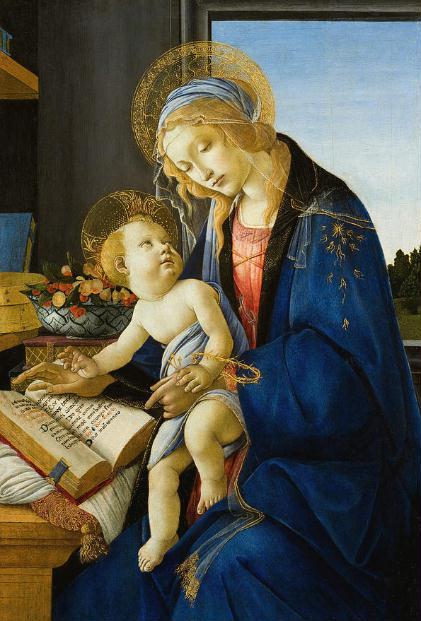
Blue Nude, Picasso (1902)
The use of the monochromatic blue and blue-green as well as the subject matter may also have acted as a form on art therapy for Picasso as he tried to come to terms with his various crises. It may also be a reflection of his guilt regarding his friend’s death as he was not there to help him in his hour of need resulting in Carlos’s suicide.While reading about Picasso’s Blue Period I found out that making the color blue for painting was very difficult until the early nineteenth century. For millennia, the only blue available was ultramarine (beyond the sea) which was ground up from the semi-precious stone lapis lazuli.Lapis lazuli was mined in the Badakhshan province in Northeast Afghanistan from Neolithic times and it was transported all over the ancient world. These Afghan mines were the sole known source of lapis lazuli and so the price of this semi-precious gemstone and the ground up pigments that made the paint ultramarine was extremely expensive. This meant lapis lazuli and ultramarine were the preserve of royalty and the ruling elites. As usual.
lapis lazuli link bracelet
Lapis Lazuli artefacts such as beads, statuettes and carvings have been found all over the ancient world in places like the Indus Valley, Mesopotamia, the Caucasus and Egypt. Perhaps the most famous use of lapis lazuli occurs in Ancient Egypt in the funeral mask of the Pharoah Tutankhamun where it was used on the eye surrounds and eyebrows. Lapis lazuli is also mentioned a number of times in the Mesopotamian poem the Epic of Gilgamesh, (17th-18th century BC) which is one of the oldest known surviving works of literature.
mask of Tutankhamun (1323 BC)
In the early Middle Ages, lapis lazuli was being exported to Europe and the pigment ultramarine was now being called “true blue.” When it arrived in Venice, lapis lazuli/ultramarine/”true blue” became the most valuable and desired paint color in European Middle Ages. Lapis Lazuli was as expensive as gold and given its prohibitive cost it was only used for the most important subjects such as the Virgin Mary and only the most affluent patrons could commission art works which invariably meant only the Church could afford such projectsDuring the early medieval period, blue did not feature much in Christian iconography and it is only with the arrival of stained glass making did the color attain its symbolism and meaning. Apparently, from the twelfth century blue glass began to symbolise divine light. The color came to represent heaven and more particularly, the Virgin Mary and the Child Jesus.In many ways, blue became associated with Mary’s mourning for the death of Jesus and in the twelfth century the color became more luminescent thereby wrapping Mary in divine and holy light. In turn, this meant blue grew in popularity, value and religious implication for medieval peoples in Europe.
Madonna of the Book, Botticelli (1480)
Consequently, blue pigment became more and more expensive and artists needed to use it sparingly in their artwork. Apparently, Raphael gained a reputation for being frugal due to his limited use of ultramarine such in the final finish for Mary’s blue robe. Vermeer, on the other hand bought so much blue that his family got into financial difficulties due to his largesse.Further investigation revealed that over the centuries, the high cost and high demand for blue was becoming more and more prohibitive. The search for a cheaper alternative blue pigment meant that in 1824 France’s Société pour l’Encouragement d’Industrie offered a princely 6000 francs reward to anyone who could invent a synthetic color ultramarine blue. As ever, when financial inducements are offered, human ingenuity, motivation and skulduggery is stimulated and even encouragedWithin two years, a German professor, Christian Gmelin and a French chemist, Jean Baptiste Guimet, both invented synthetic ultramarine. However, as French national honor was at stake, the French chemist was declared the winner and received the prize money. The reaction of Christian Gmelin to the news of the French victory is unknown.As time passed, the invention of synthetic blue paint meant the color blue was now cheaper and more widely available to artists and lapis lazuli was no longer required. Demand for this commodity began to wane as artists embraced the new paint technology. The price of lapis lazuli fell and the need to transport it all the way from Afghanistan evaporated. Supply and demand in action the free marketeers might say.So, if you are looking for somewhere to visit in 2023 then look no further than Barcelona and the exhibitions that celebrate the great artist, Pablo Picasso. There you can marvel at his genius and the story behind the color blue.Lapis Lazuli
From Neolithic Man in the mountains ofAfghanistan all the way through to the
Taliban, men have fought over your lustrous form
From Sar-i Sang’s towering citadel stronghold
Your fame spread south, east and
West without stopping for pause or rest
Your deep, deep blue was speckled, freckled
With Mica white pulsating a vibrant midnight
Star bright night
You were bestowed with spiritual essence, an
Almost mystical presence infusing burial beads,
Tutankhamun’s Mask and the heavened Sistine Chapel
Now you’re bought and sold, more expensive
Than gold, for bullets and bombs, to destabilise,
Terrorise global populations
But the mindless acts of mediocre men will
Not despoil your beauty, your wisdom. Your peace
Shines through, untarnished, undimmed as before.
Dermot Moroney 2023 Email ThisBlogThis!Share to TwitterShare to Facebook
